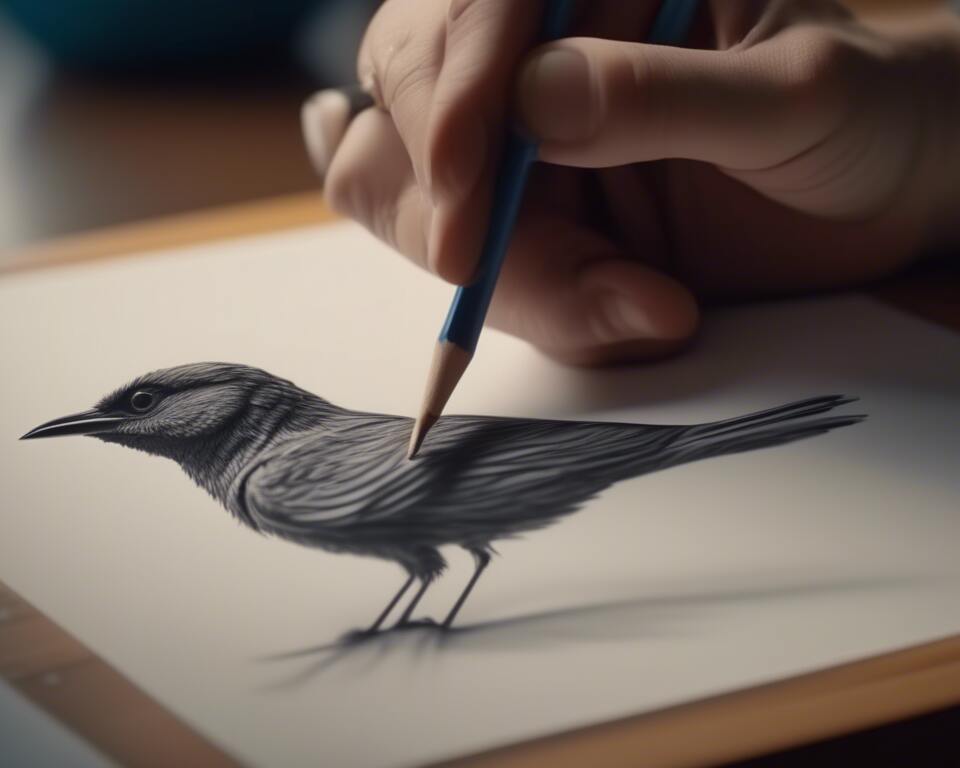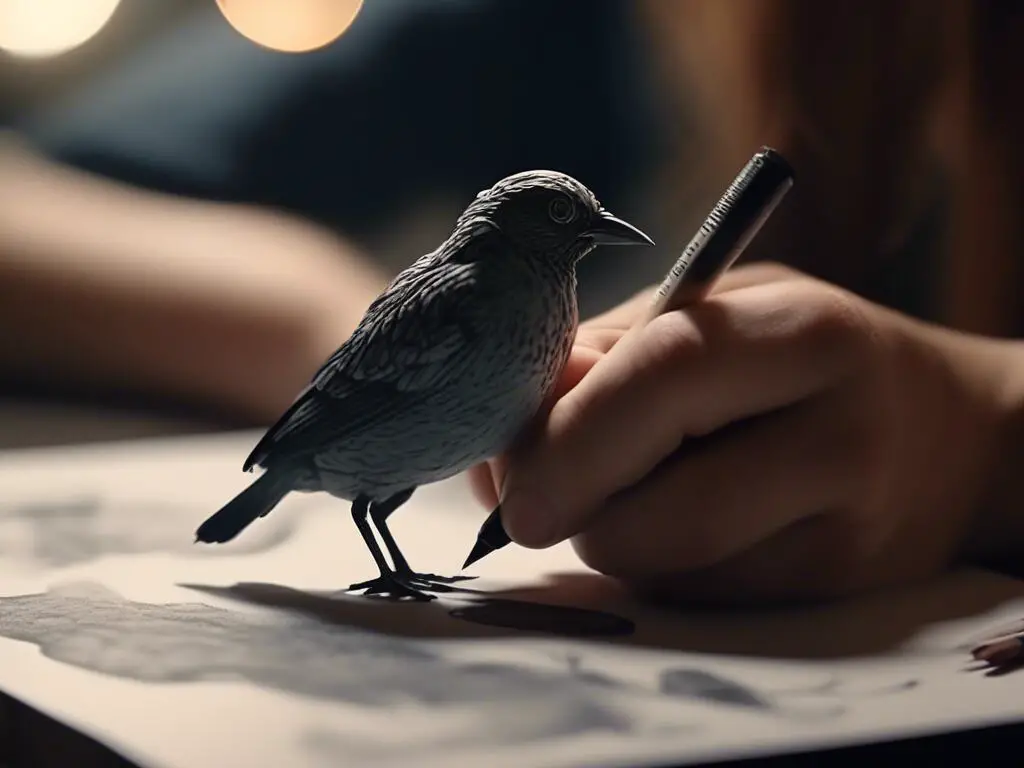Have you ever wanted to capture the beauty of a bird on paper? Whether you’re an aspiring artist or simply looking for a relaxing hobby, this comprehensive guide will walk you through drawing your very own feathered friend. No images needed – just your imagination and our detailed instructions!
Table of Contents
- 1 Why Drawing Birds Can Enhance Your Life
- 2 Gathering Your Art Arsenal
- 3 Your Step-by-Step Flight Plan to Drawing a Bird
- 3.1 1. Lay the Foundation with Basic Shapes
- 3.2 2. Give Your Bird Its Distinctive Silhouette
- 3.3 3. Wing It with Confidence
- 3.4 4. Get a Leg (or Two) Up
- 3.5 5. Bring the Face to Life
- 3.6 6. Feather the Nest (or Bird, in This Case)
- 3.7 7. Refine Your Feathered Friend
- 3.8 8. Add Personality with Final Touches
- 4 Avoiding Common Nesting Mistakes
- 5 Soar Higher: Tips for Elevating Your Bird Drawings
- 6 Wrapping Up Your Avian Adventure
- 7 Frequently Asked Questions
- 8 Author
Why Drawing Birds Can Enhance Your Life
Before we dive into our avian adventure, let’s explore why drawing birds is more than just a pastime:
- Sharpens your observational skills, making you more attuned to nature
- Improves hand-eye coordination, benefiting various aspects of life
- Provides a calming, meditative activity to reduce stress
- Deepens your appreciation for the intricacies of natural design
Gathering Your Art Arsenal
Let’s start by ensuring you have the right tools for the job:
| Essential Item | Description | Purpose |
|---|---|---|
| Pencil | HB or 2B | For initial sketching and details |
| Eraser | Soft, pliable | To gently remove mistakes |
| Paper | Smooth, medium weight | Your canvas for creation |
| Colored pencils (optional) | Set of 12 or more | To bring your bird to vibrant life |
Pro Tip: Place your materials on a clean, well-lit surface. Good lighting is crucial for seeing the subtle lines and shapes you’ll be creating.

Your Step-by-Step Flight Plan to Drawing a Bird
In this section, we’ll guide you through each step to master the art of drawing birds. From sketching outlines to adding intricate details, you’ll learn how to bring these feathered beauties to life on paper.
1. Lay the Foundation with Basic Shapes
- Start with the body: Draw an oval about the size of a small potato on your paper. This is your bird’s body.
- Add the head: Slightly to the upper right of the body, sketch a circle about the size of a grape. This represents the head.
Visualization Tip: Imagine you’re drawing the outline of an egg attached to a small ball. The proportions should be roughly 2:1, body to head.
2. Give Your Bird Its Distinctive Silhouette
- Connect head and body: Draw smooth, curved lines joining the grape-sized head to the potato-sized body. Think of it as drawing a sleek, streamlined teardrop shape.
- Beak time: At the front of the head circle, add a small triangle – picture a tiny pizza slice pointing outward.
- Tail feathers: From the back of the body oval, extend lines outward to form a fan shape, like the spread of a handheld fan.
3. Wing It with Confidence
- Main wing line: From the top of the body, draw a curved line down to the middle, as if you’re tracing the upper edge of a crescent moon.
- Feather hints: Along this curve, add short, gentle curved lines, like gentle ocean waves, to suggest feathers.
4. Get a Leg (or Two) Up
- Legs: From the bottom of the body, draw two thin lines downward, about as long as the head is wide. Think of them as delicate twigs.
- Feet: At the end of each “twig,” add three small lines spreading outward, like a tiny trident or fork.
5. Bring the Face to Life
- Eye placement: In the head circle, about 1/3 from the top and slightly toward the front, draw a small circle the size of a pea.
- Pupil: Inside this eye circle, add an even smaller circle, like a tiny seed.
- Feather texture: Around the eye and over the head, make short, gentle curved lines to suggest small feathers.
6. Feather the Nest (or Bird, in This Case)
- Body feathers: Over the body oval, draw overlapping curved lines, like gentle rolling hills or fish scales.
- Wing details: On the wing, make longer, more pronounced curved lines to represent larger feathers.
- Tail definition: Draw individual feather shapes on the tail, like elongated leaves on a stem.
7. Refine Your Feathered Friend
- Smooth the outline: Gently refine the overall shape, softening harsh lines and adjusting proportions if needed.
- Erase guide shapes: Lightly erase the initial oval and circle shapes, leaving your refined bird outline.
8. Add Personality with Final Touches
- Wing tips: At the end of the wing, draw a few separated lines to indicate primary feathers, like spread fingers.
- Beak texture: Add a small line on the beak to define the mouth.
- Leg scales: Draw tiny horizontal lines on the legs to suggest scales.
- Environment (optional): Add simple shapes around your bird to suggest branches, leaves, or sky.
Avoiding Common Nesting Mistakes
- “Incredible Shrinking Bird”: Resist the urge to draw too small. Your bird should comfortably fill a good portion of your paper.
- “Feather Faux Pas”: Don’t forget to add texture! Smooth birds exist only in the realm of cartoon golf mascots.
- “Proportion Distortion”: Keep the body larger than the head, and the head larger than the beak.
- “Soulless Stare”: The eye brings your bird to life – give it attention and detail.
Soar Higher: Tips for Elevating Your Bird Drawings
| Tip | Description | Why It Works |
|---|---|---|
| Daily Sketching | Spend 10 minutes each day drawing birds | Builds muscle memory and observation skills |
| Bird Watching | Observe real birds in your environment | Improves understanding of anatomy and behavior |
| Photo References | Use bird photos for accuracy | Helps refine details and proportions |
| Style Exploration | Try realistic, cartoonish, and abstract birds | Develops versatility and personal style |
Wrapping Up Your Avian Adventure
Remember, every master artist started as a beginner. Your first bird drawing is a celebration – it’s the starting point of your artistic journey. With each sketch, you’ll see improvement, building your skills and confidence.
Frequently Asked Questions
- How long until I’m drawing birds like Audubon?
While we can’t all be Audubon overnight, with daily practice, you’ll see significant improvement in just a few weeks! - Can I use this method for different bird species?
Absolutely! The basic shapes and steps apply to most birds. Adjust sizes and add specific features (like a woodpecker’s long beak or an owl’s large eyes) as needed. - What if my bird looks more like a feathered potato?
Embrace it! Every artist has their own style. Keep practicing, and your “feathered potatoes” will evolve into recognizable birds before you know it. - Are there digital options for bird drawing?
Yes! Many artists use tablets and software like Procreate or Adobe Fresco. The principles remain the same – digital just offers an undo button! - Is this guide suitable for children?
Definitely! Kids often have a natural, uninhibited approach to art. Encourage them to follow along, prioritizing fun over perfection.
Now, pick up that pencil and let your imagination take flight! Your artistic journey into the world of bird illustration begins now. Remember, practice makes progress, and every drawing is a step forward in your creative adventure.


